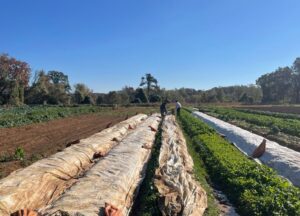Sunday night we got our first frost and our first hard freeze of the season with the low around 27 degrees. It’s expected to be several degrees colder tonight. Monday Meg and I harvested as much as we could of the crops I was afraid might be damaged by the cold. It rained gently all morning and into the afternoon. I’m grateful for the rain, we really needed it badly. We need more. But it did make for an exceptionally unpleasant work day yesterday. Today we harvested some more, and covered some immature crops with row cover. We unhooked water lines and set up space heaters. We tested the propane heater in the greenhouse. We tried to get our brains back into winter mode.
How cold is too cold?

How cold is too cold for cabbage? Lettuce? For frost sensitive crops like tomatoes and other summer vegetables, it’s pretty simple. Temperatures below 40 might damage the leaves, but “too cold” comes pretty consistently at 32 degrees. For cold tolerant crops, it is more complicated than it seems. First, different varieties of the same vegetable can be more or less cold hardy. I love our “Green Magic” broccoli, but it is a major wimp when it comes to the cold. A freeze will ruin the heads. This year we are trying out a new variety, “Kariba”, that is supposed to be exceptionally cold tolerant.
Second, how quickly the weather changes can have an impact. The best scenario for your veggies is when the temperature gradually drops over the course of weeks. That gives the plants time to develop their natural defenses. But this cold weather came quickly. A hard freeze before we’ve even has a frost. I’m not expecting our crops to be as resilient as they normally would. And there are other factors – duration of the cold, the temperature of the soil, stress on the plant from pests, for example.
So as a farmer this weather can be very stressful. What do I harvest, what do I cover with fabric, what do I leave alone to fend for itself? The broccoli gets harvested, the lettuce gets two layers of row cover, the cabbage gets one, the watermelon radishes and rutabagas should be fine with nothing. But what if I’m wrong? Better safe than sorry, you might think, but we don’t have the time or resources to cover (and then uncover) everything.
Small Share
- Napa Cabbage
- Butternut squash
- Bok Choi
- Cauliflower
- Hakurei turnips
- Head lettuce
Full share
- Sweet potatoes
- Hakurei turnips
- Daikon radish
- Juliet tomatoes
- Fennel
- Green & red head lettuce

You must be logged in to post a comment.